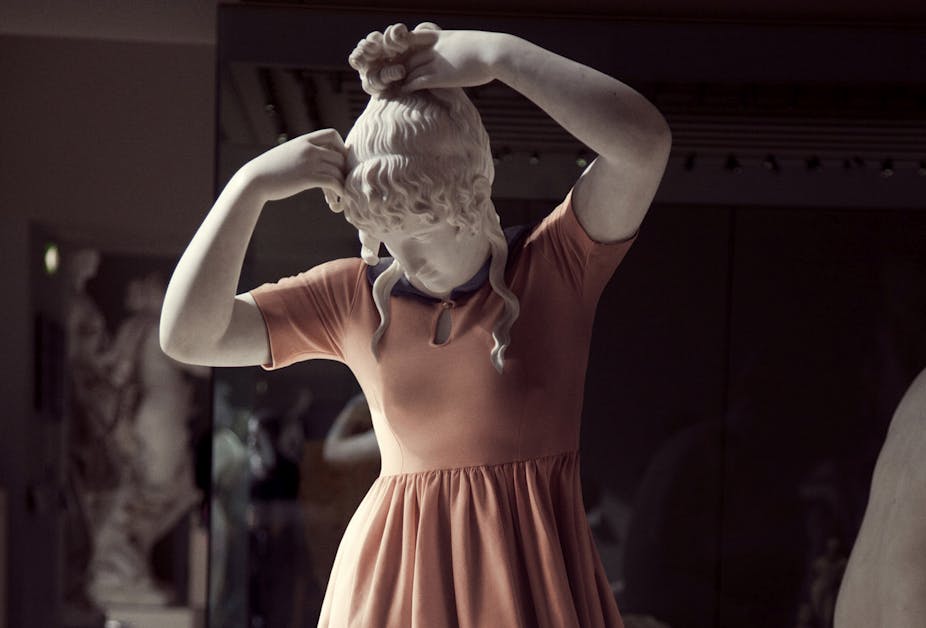For the ancients, statues held power and inspired awe. They symbolised the presence of the gods, epitomised ideal forms and represented cultural supremacy.
But like all ancient artefacts revered today, the sculptures of Greece and Rome were also part of everyday life. People walked past them on their way to the market. They assimilated them into the landscape and dressed them up on special occasions. They were also, according to archaeologists such as Vinzenz Brinkmann, originally painted in bright, even gaudy colours.

The idea that such celebrated and decidedly monochrome sculptures were once coloured may come as a bit of a shock. The works of antiquity, now classified as masterpieces, are the essence of their bronze or marble material, and are to be venerated in museum rooms. Right?
Not according to an increasing number of artists who enjoy reinterpreting artistic masterpieces – and especially not according to French photographer Gerald Bruneau.
Last month, it was reported that Bruneau had caused an uproar in Italy because he was caught dressing up the famous Riace Bronzes. These two august figures, in all their naked glory, are housed at the Museo Nazionale della Magna Grecia in Reggio Calabria (Southern Italy).
Bruneau was among a group of photographers invited to promote the sculptures abroad. In view of the media attention, even critics would have to admit, he achieved his brief.
Besides the fact that Bruneau actually touched the precious bronzes, his taste in clothing left a lot to be desired: a hot pink feather boa, a leopard-print G-string and voluminous bridal veil.
The intense embarrassment of museum officials is evidenced by how long they managed to conceal the incident. While media agencies have only recently reported the event, it had taken place in 2013 and was only leaked last month by the Italian newspaper, Dagospia.
The fact that the photographs are controlled by strict copyright (although they can be found on the Web) is also indicative of authorities’ embarassment.
Old art is deemed to be priceless. What is priceless is deemed to be extraordinary. What is extraordinary requires protective boundaries. The boundaries, in turn, reiterate what is priceless. Thus we have fetishism and circular argument.

Of course the Riace Bronzes are fragile: they are housed in a climate-controlled room and stand on purpose-built pedestals designed to resist movement. Bruneau transgressed the borders and violated the sacrosanct rule of museums and galleries: DO NOT TOUCH.
But surely Bruneau’s act of touching and the outrage it generated should be accompanied by the questions: what makes ancient art masterpieces and why do people get so emotional when these masterpieces are perceived to have been abused?
Art such as the Riace Bronzes do make us emotional. We marvel at the symmetry and artistic execution of what stands before us. We venerate the artistic virtuosity of the sculptor.
But art also elicits other, equally legitimate emotions – pity, excitement and anger. And it should. It should also, surely, remain open to transformation and re-interpretation. Marcel Duchamp explored such concepts almost 100 years ago with the first of his L.H.O.O.Q ready-mades, which depicted the Mona Lisa sporting a goatee and moustache.
People were outraged. People were unsettled. And so art won the day. The artist did his job.

Duchamp not only transformed an existing work of art to create a new one. He participated in the artistic imperative: to engage in dialogue, to make us think harder and to question more. Part of the conversation elicited by Duchamp was to reconsider gender, its stereotyped markers and its plasticity.
He also challenged the pervasive but often politely side-stepped elephant in the art room – namely art is often about sex (read quickly in French, L.H.O.O.Q sounds like a sentence that translates as “She has a hot ass”).
Bruneau has done the same.
By adorning the hyper-masculine sculptures he reminds us that issues of gender and sex fascinate artists, who are at liberty to make of them what they will. While he has made few public statements, Bruneau did say the act was a humorous comment on the marriage equality debate:
Down in the south of Italy the men are very macho and conservative and are very upset by the idea of gay marriage.
What better way to interrogate machismo and homophobia than dressing up sculptures in drag?
Ironically, after years of bureaucratic infighting the sculptures are off to Milan for Expo 2015. While they will be painstakingly transported, some commentators have suggested that the safety of a national treasure has been compromised for the sake of a much needed boost to the beleaguered Italian economy.
Let’s hope the transportation won’t damage the Riace Bronzes as much as Bruneau’s feathers did.

